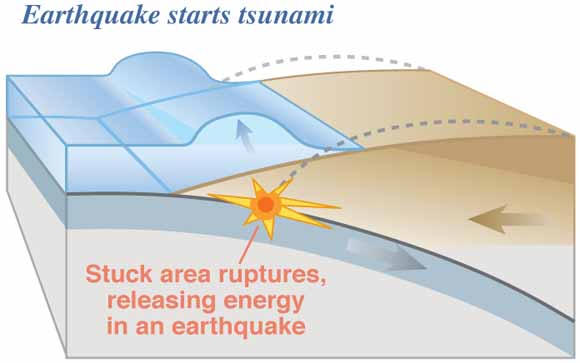TsunamiA tsunami is a fast moving, long wavelength water wave generated by a sudden displacement of water by undersea landslides, earthquakes, or volcanic activity. They are commonly called "tidal waves", but are by no means created by the tides. The sudden slippage of the ocean floor near the source of an earthquake can send a train of seismic waves across the ocean. When an overriding plate along a subduction zone suddenly breaks free it moves upward raising the sea floor and the water above. The waves move outward in ever-expanding circles, nearly imperceptible in deep ocean water. As they approach land, water recedes from the shore. This dramatic action often entices the curious to investigate. But very shortly a water wave rises rapidly from the ocean surface, crashing onto shore and rushing landward.
Figure 15.33 Formation of a tsunami On December 26th, 2004 subduction between the Indian and Eurasian
(more specifically the Burma)
plates off the coast off the coast of Indonesia resulted in a
magnitude 9 earthquake and large
tsunami that
devastated South Asia. [Watch
Figure 15.34 View "Killer Tsunamis" from National Geographic One of the largest earthquakes to occur in recent memory occurred March 11, 2011 off the coast of Japan. The huge tsunami it created devasted the northeast coast of Japan, destroying towns and infrastructure. Learn more about this magnitude 9 earthquake and its aftermath by "Digging Deeper: The Great East Japan Earthquake of 2011", or skip and continue reading.
Assess your basic understanding of the preceding material by "Looking Back: Crustal Deformation" or continue reading. |
